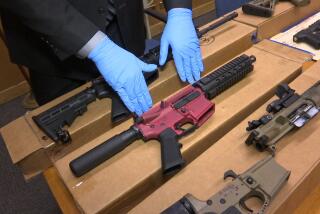Teaching Kids That Guns Arenât Toys
Farideh Kioumehr didnât intend to devote her life to child safety, it just seemed to fall into her lap. And like an adult being cradled on the tiny legs of a child, her passion to end gun violence has become a weighty proposition that consumes her waking hours. Itâs a burden sheâs happy to carry.
âTry to imagine a world where there is no violence whatsoever,â the energetic mother of two said. âI know itâs very idealistic, but if parents and grandparents and teachers and politicians could come together and teach their children a peaceful message, the world would be a different place.â
Kioumehr says she wonât rest until her message that âguns are for killing and toys are for playingâ has reached a culture saturated with violence. She believes the place to begin is with kids.
To that end, the Sherman Oaks epidemiologist, who heads the International Health and Epidemiology Research Center, founded the Anti-Violence Day Project two years ago, in which she visits schools and invites the children to turn in their toy guns.
In return for surrendering play guns and participating in the dayâs events, the kids receive T-shirts and certificates acknowledging their help in the campaign to âhelp save lives.â
âThe program is such a success,â said Robert Barner, head of the Los Angeles Unified School Districtâs Jordan/Locke Cluster, which lent financial support to a recent Anti-Violence Day event at the Watts Tower Art Center. âDr. Kioumehr is a real visionary. We all benefit from her work.â
According to research by Kioumehr and studies conducted by organizations nationwide, the leading cause of injury and death for those younger than 18 is handgun violence.
The use of toy guns in the commission of crimes has also risen sharply, often with tragic results. A youth was shot twice by a Los Angeles County sheriffâs deputy in 1995, when he mistook the childâs $2 toy gun for a .22-caliber pistol.
âI want to teach kids, the younger the better, that toy guns are dangerous,â Kioumehr said. âOlder kids need to hear that guns are used for one reason only: killing. Unfortunately, gun-related violence is increasing and getting younger all the time.â
Kioumehrâs upbringing was anything but violent. Born and educated in Iran, she received a degree in veterinary medicine before heading to the United States to earn a doctorate in public health, with a specialty in epidemiology.
She and her husband, physician Reza Dadsetan, returned to Iran in the late â70s to teach at a Tehran medical school, but fled the country a month after the revolution began.
The couple settled in Sherman Oaks with their two children in 1990. Five years later, after her 10-year-old son came home from a birthday party wielding a toy gun, she began her anti-violence campaign. She knew then she had found her cause.
Although Kioumehrâs civic contributions have been recognized with a number of accolades, including 1996 and 1997 Fernando Award nominations, funding for her nonprofit organization comes in fits and starts, mostly out of her own pocketbook. She vows to bring her message to the cityâs children no matter what it takes.
âWhat I get out of this is the joy of helping people,â Kioumehr said. âIf I can save just one life, that is my reward.â
*
Personal Best is a weekly profile of an ordinary person who does extraordinary things. Please send suggestions on prospective candidates to Personal Best, Los Angeles Times, 20000 Prairie St., Chatsworth 91311. Or fax them to (818) 772-3338. Or e-mail them to [email protected]
More to Read
Sign up for Essential California
The most important California stories and recommendations in your inbox every morning.
You may occasionally receive promotional content from the Los Angeles Times.










